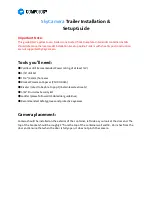
V1.02
Thom Hogan’s Complete Guide to the Nikon D300
Page 672
Picture Control
Sharpening 4 or higher*
Contrast
0
Brightness 0
Saturation 0 or +1*
Color Space sRGB
Active D-Lighting Low*
Autofocus Mode
AF-S (Single Servo)
Autofocus Area Mode Auto Area
Metering Method
Matrix Metering
Internal Flash Mode TTL
File No. Seq.
ON
Image
Rotation
ON
As for exposure mode, I’d suggest Aperture-priority, though
Program exposure mode is okay if you avoid using the flash.
With the camera set as described, you’ll get very usable
pictures out of the camera with minimal hassle. These photos
will work on the Web, with PictBridge printers, and with most
labs. You’re compromising a bit on image quality (automatic
white balance can produce slightly off color images, but
usually only slightly). Read the section on “Dealing with
JPEG,” below, for more tips on image quality.
The autofocus system will work hard to figure out what is and
isn’t the subject (in low light you might have some speed
issues with focus, but that’s why you’ll leave AF Assist
On
).
If you’re trying to get the most quality you can out of your
D300, then you’ll be changing your settings quite a bit to
optimize for each situation you encounter. A few, however,
need to be called out here:
Image Quality
NEF (Raw)*
NEF (RAW) recording
Lossless, 14-bit*
ISO
200 to 400 max, LO 1.0 in low contrast*
White Balance
Preset manual* or actual condition*
Color Space sRGB
155
155
Because the color LCD is close to sRGB.
















































